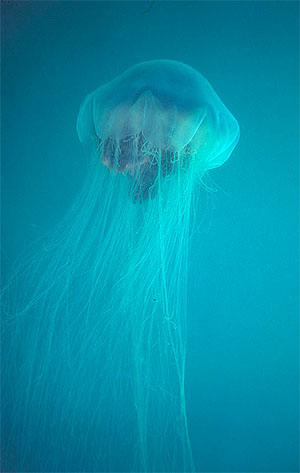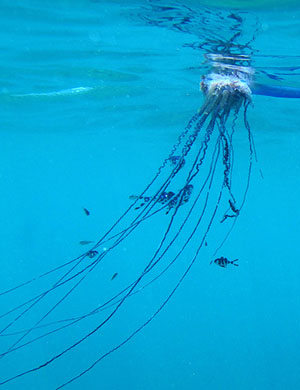Jane Allin loves kayaking. A lot. She often spends up to four hours a day on the water when she’s at her home in Port Medway, a community on Nova Scotia’s South Shore about 30 minutes outside of Bridgewater.
Last year, the retired elementary school teacher and principal (who splits her time between Nova Scotia and Ontario) added an extra task to her paddles on the ocean. It all started when Jane‚Äôs husband came across an article in a local newspaper about a Ľ∆…ę÷Ī≤• researcher looking for help counting jellyfish. Jane reached out and, before she knew it, was contributing to a region-wide study on jellyfish patterns, part of a broader effort to better understand feeding habits of the endangered leatherback sea turtle.
 ‚ÄúIt‚Äôs made me more curious,‚ÄĚ says Jane, who is now in her second year counting and tracking jellyfish. ‚ÄúYou start with jellyfish, and you start finding other things you‚Äôd never noticed before.‚ÄĚ
‚ÄúIt‚Äôs made me more curious,‚ÄĚ says Jane, who is now in her second year counting and tracking jellyfish. ‚ÄúYou start with jellyfish, and you start finding other things you‚Äôd never noticed before.‚ÄĚ
Another South Shore resident, Judy Bowers, does her jellyfish counts from land. She and her husband walk the sea shore frequently, but it‚Äôs on Mondays that they do their count. He brings the measuring tape ‚ÄĒ¬†to track the size of beached jellyfish ‚ÄĒ while she takes the notebook and documents what they find.
‚ÄúBefore they were just little blobs on the sand,‚ÄĚ says Judy. ‚ÄúNow I know what they are, and a bit more information about them. It makes our walks more interesting too.‚ÄĚ
Jane and Judy are two of more than 50 ‚Äúcitizen scientists‚ÄĚ across Atlantic Canada contributing their eyes, and pens, to Dal student Bethany Nordstrom‚Äôs master‚Äôs project this summer. Their collective efforts represent an engaging, community-based solution to the challenge of tracking the elusive jellyfish.
Understanding turtle feeding habits
‚ÄúElusive‚ÄĚ might seem a strange phrase to describe a creature that pretty much everyone has seen on the beach at one point or another. But, as Bethany explains, jellyfish are notoriously difficult to research.

‚ÄúA turtle, for example, you can put a tracker on it, follow it, get a sense of their migration patterns,‚ÄĚ she says. ‚ÄúBut jellyfish show up sporadically with little warning, and can disappear just as quickly.‚ÄĚ
There are many reasons why researchers like Bethany would want to better understand how and when jellyfish appear off our shores, from public safety (their stings can pack a small-but-mean punch) to environmental concerns (jellyfish are often an indicator species that helps illuminate different facets of ocean health). But Bethany’s particular interest concerns an annual visitor to the North Atlantic: the leatherback sea turtle.
Each summer, Atlantic Canada hosts one of the highest density of foraging leatherbacks in the North Atlantic, as the endangered turtles swim north from tropical waters specifically to feed on jellyfish. The leatherbacks have fascinated Bethany ever since she was little.
 ‚ÄúI grew up in southern New Brunswick, just off the Bay of Fundy, and as a kid I was really obsessed with frogs and creepy-crawly things and also the ocean,‚ÄĚ she says. ‚ÄúSo when I found out there was a reptile that lived in the ocean and that was close to our waters, I was really excited and then became slightly obsessed with them.‚ÄĚ
‚ÄúI grew up in southern New Brunswick, just off the Bay of Fundy, and as a kid I was really obsessed with frogs and creepy-crawly things and also the ocean,‚ÄĚ she says. ‚ÄúSo when I found out there was a reptile that lived in the ocean and that was close to our waters, I was really excited and then became slightly obsessed with them.‚ÄĚ
After completing an undergrad degree in wildlife conservation at the University of New Brunswick, Bethany came to Ľ∆…ę÷Ī≤• to study with along with Mike James, a Department of Fisheries and Oceans researcher who‚Äôs the leading expert in Canadian sea turtles. (Bethany also works in collaboration with the .)
Together, they identified the turtles‚Äô prey field as an area worthy of further research. By studying the turtles‚Äô main food source ‚ÄĒ¬†jellyfish ‚ÄĒ Bethany is hoping to learn more about their‚Äô feeding patterns. In particular, she‚Äôs interested in the spatial and temporal patterns of jellyfish in Atlantic Canada, and what size jellyfish patches are required to attract and retain the turtles in a certain area.
Engaging the community
Which brings us back to Bethany’s jellyfish challenge: how do you study an organism that’s so difficult to track?
Part of her solution is to focus a portion of her efforts on a known leatherback foraging ground: an area of the ocean off the coast of Cape Breton where leatherbacks have been studied for over 15 years. She’s spending time there this summer using acoustic technology to try and determine just how many jellyfish there are under the waves. (The turtles dine on their prey at the surface, but they bring them up from the depths.)

‚ÄúBut in order for me to look at jellyfish across the Atlantic Provinces, we quickly realized I wasn‚Äôt able to do it by myself,‚ÄĚ Bethany explains. ‚ÄúI wasn‚Äôt going to be able to be out visiting 40 sites across the provinces on boats and beaches looking for jellies.‚ÄĚ
It was Dr. Worm who suggested using citizen science ‚ÄĒ a blanket term to describe involving the general public as active participants in scientific research. The idea was to find community members around the Atlantic provinces who would report back to Bethany about jellyfish they were seeing in their waters. Last summer, Bethany spent a couple of months seeking out volunteers. She did TV interviews, spoke with radio stations, and pitched local community newspapers for coverage.
‚ÄúAt first I was a little bit skeptical; I wasn‚Äôt sure who would commit to wanting to do these surveys,‚ÄĚ she says. ‚ÄúBut I couldn‚Äôt believe how many people responded and said they wanted to.‚ÄĚ
After a successful summer, many of the volunteers ‚ÄĒ¬†like Jane and Judy ‚ÄĒ¬†have returned for a second season of jelly-watching. Bethany mails each of them a jellyfish monitoring kit, which contains the data sheets to fill out along with rulers, gloves and a guide to different species of jellyfish. The volunteers are expected to fill out their data sheets weekly, and while they‚Äôre not required to report to Bethany each week, many do so.
Bethany also accepts info on jellyfish sightings from anyone, anytime, on what she calls her ‚Äújellyfish hotline‚ÄĚ ‚ÄĒ¬†a jellyfish@dal.ca email address.
‚ÄúThere are so many people these days interested in getting involved in science,‚ÄĚ she says of her approach. ‚ÄúI think a lot of it has to do with all the information coming out on climate change, and hearing about biodiversity crises and whatnot in the news. People are becoming more and more engaged and want to know what they can do to help.‚ÄĚ
Stings and other things
In the process of finding and organizing her volunteers, Bethany has become a go-to expert for journalists and others looking to learn more about jellyfish. That led to a bunch of interviews this summer when sightings emerged of Portuguese man o’ war in Nova Scotian waters.
 ‚ÄúThey‚Äôre actually a siphonophore ‚ÄĒ¬†they‚Äôre related to jellyfish, but belong to a different order,‚ÄĚ explains Bethany, who says she‚Äôs not surprised that the creatures ‚ÄĒ rare to our shores ‚ÄĒ garnered such attention, given their reputation.
‚ÄúThey‚Äôre actually a siphonophore ‚ÄĒ¬†they‚Äôre related to jellyfish, but belong to a different order,‚ÄĚ explains Bethany, who says she‚Äôs not surprised that the creatures ‚ÄĒ rare to our shores ‚ÄĒ garnered such attention, given their reputation.
‚ÄúThey‚Äôre really pretty, but they are dangerous, so I see how people reacted in such a way. But it was important to do all these interviews because many people seemed to think that their stings are fatal, which isn‚Äôt necessarily true.‚ÄĚ (While the man o‚Äô war‚Äôs sting is much more severe than your traditional jellyfish, deaths usually only occur in rare cases where the venom causes an allergic reaction.)
Bethany herself has yet to be stung by any sea creature, even the jellyfish she’s been researching for two summers. But as she looks ahead to completing her thesis over the next year, and ahead to what she hopes are further adventures in marine science, she’s optimistic that her work will have an impact on the sea turtles that first inspired her so many years ago.
‚ÄúWe have one of the largest foraging populations here in our Atlantic waters. It‚Äôs critical that we understand the habitat that they‚Äôre using and their requirements, so we can continue to protect this area for them.‚ÄĚ

Photo credits:
Beach photos: Danny Abriel
At-sea photo: Canadian Sea Turtle Network
Jellyfish photo: Derek Keats (used under Creative Commons license)
Leatherback sea turtle photo: Scott R. Benson, NMFS Southwest Fisheries Science Center (used under Creative Commons license)
Portuguese man 'o war photo: Sean Nash (used under Creative Commons license)

